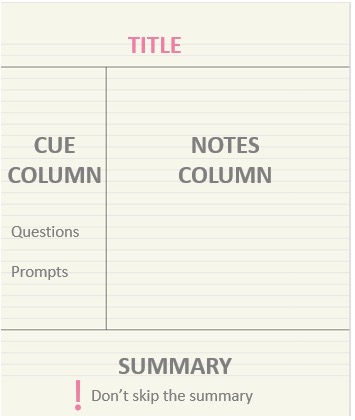A common question I get asked a lot by students is “how can I take good notes in class or in a study session”.
Some students do not enjoy taking notes and that is perfectly fine. It will depend on the students own natural style. Kinaesthetic learners generally like to take notes as they tend to be active learners.
When I was studying for my university exams and my professional exams, my note taking style was ineffective. If there was 20 pages in my required reading, I would write 20 pages of notes. When I reflect on this, I can honestly say I probably only used one quarter of the notes I wrote.
The reason I wrote so many notes was I thought it was valuable opportunity to embed information into my memory. I felt like I was doing something, and I was being productive. In essence this was not an effective study skill to pass an exam. When studying we want to be testing our self-knowledge as much as possible. Writing out pages and pages of notes is not an academic challenge. While you might retain some information as you are writing out notes, unless you test or challenges yourself on what you have written it is a fruitless exercise.
There are many note taking styles out there but there is one good note-taking strategy that I want to introduce you to. It is called the Cornell Note Taking System.
Cornell Note Taking System
This was developed by Walter Pauk, a professor at Cornell, in the 1950s. It has remained the most useful note taking strategy for students to record key information. It is useful for student who want to create their own study-guide and useful reference system within their notes.
How it works?
With a piece of paper, draw a line down your page, leaving a 2/3 inch margin on the left (which we will call the cue column) and a six-inch area to the right (which we will call the notes column). At the bottom of the page, leave room for a summary. Your page will look like this:

Notes Column
Give each page a title so you have a headline idea of what the notes are. The title might be the name of a lecture or chapter of a textbook you are studying.
The notes section is where you write down the important points your educator is making, or it is where you are taking down important points in your textbook. You don’t need to write down every word. You want to get the important details or the information you think you need to know.
Cue
The cue section is used for all kinds of questions prompts and comments. For me I like to keep the cue section for questions. The cue section is used after you take notes. This is where you add question to help you remember or organise your material.
Summary
The summary is where you ask yourself what did you learn today? This is a reflective piece where you can write what you learnt in just a few sentences. The summary can be challenging but don’t skip it. Do the summary soon after the learning while the information is still fresh in your mind. Look back at the summary before your next class or study session is a good way to see connections throughout your study.
The benefits of this note-taking method are, it is organized, easy, simple, efficient and saves time and effort.
To take this one step further, you can also test your self-using the Cornell Note-taking system. Get a blank piece of paper and cover the notes column you have taken your notes. Now, try and answer the questions you have written in the cue column. This is a great way of testing your self knowledge.
